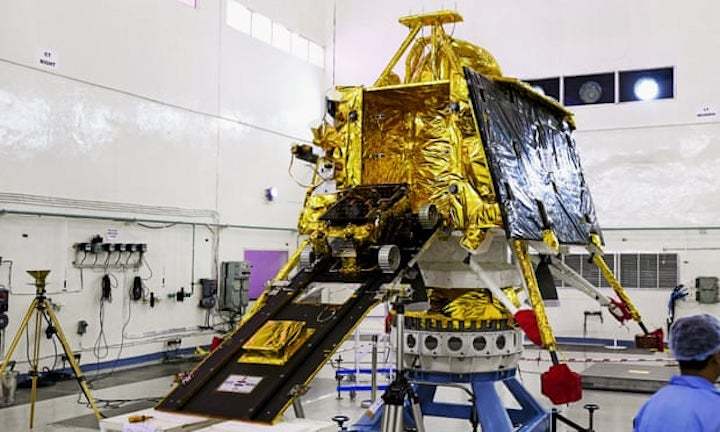India is making final preparations for the launch this Sunday of the Chandrayaan 2 moon mission. The spacecraft will take two months to cruise to the moon. Following its arrival, it will manoeuvre into a circular orbit just 62 miles (100km) above the lunar surface. It will then deploy the Vikram lander early in September.
This will be India’s first attempt at a soft landing on the moon. If successful, it will make the country the fourth to achieve such a feat, after Russia, the US and China.
The chosen landing site is near the lunar south pole, where water ice has been detected in some permanently shadowed craters. Once safely down, the Vikram lander will release a small, six-wheeled rover named Pragyan.
The three components of the mission carry a full complement of scientific instruments. Among other things, they will study the moon’s mineral and chemical composition and its topology and seismology.
India’s first moon mission, Chandrayaan 1, launched in October 2008 and operated successfully for almost a year. As part of the mission, an impact probe struck the moon’s south pole in a controlled manner.
Chandrayaan 2 will launch from the Satish Dhawan Space Centre on India’s south-east coast.
Quelle: The Guardian
----
Update: 13.07.2019
.
GSLV Mk.3 rolls out for launch of Indian moon mission
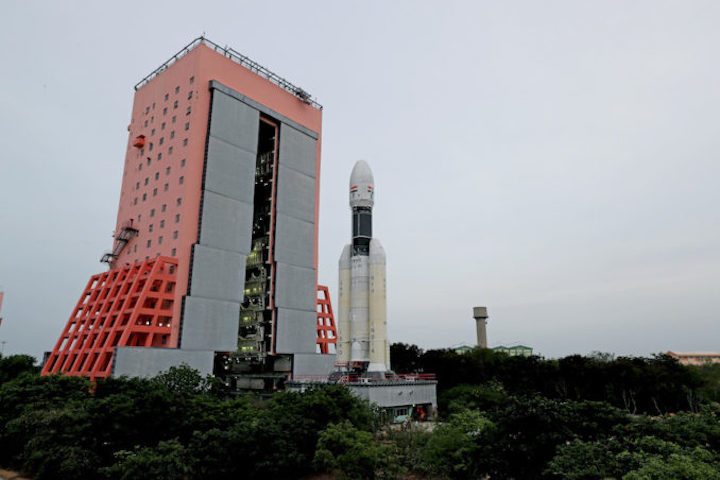
The 143-foot-tall (43.5-meter) rocket that will send aloft India’s Chandrayaan 2 moon mission Sunday has arrived on its launch pad on the Indian east coast.
The Geosynchronous Satellite Launch Vehicle Mk.3, or GSLV Mk.3, is set for liftoff at 2121 GMT (5:21 p.m. EDT) Sunday from the Satish Dhawan Space Center, India’s spaceport on the coast with the Bay of Bengal around 50 miles (80 kilometers) north of Chennai.
The launch is timed for 2:51 a.m. local time Monday in India.
The GSLV Mk.3 is India’s most powerful launcher. Indian space agency officials last year switched the launch of the Chandrayaan 2 mission from the less capable GSLV Mk.2 rocket after the spacecraft’s mass grew to exceed the mission’s original design.
The all-Indian launch vehicle and the moon-bound Chandrayaan 2 spacecraft rolled out of the Vehicle Assembly Building on July 7 at the space base, located on Sriharikota Island, on a mobile platform for the journey to the Second Launch Pad.
The rollout occurred after technicians stacked the launch vehicle’s components on the mobile launch platform inside the assembly building, and finally capped the rocket with the Chandrayaan 2 spacecraft, a three-in-one mission consisting of an orbiter module, a landing craft and a rover that will deploy from the lander after touchdown on the lunar surface.
Assuming the mission takes off Sunday — two days shy of the 50th anniversary of the launch of Apollo 11 — the spacecraft should arrive in orbit around the moon in early August, followed by separation of the lander from the orbiter for final descent and landing Sept. 6.
India is seeking to become the fourth country to achieve a soft landing on the moon, following the Soviet Union, the United States and China. The Chandrayaan 2 mission has cost around $142 million to design, develop and ready for launch, including the cost of the rocket and the spacecraft, according to the Indian Space Research Organization.
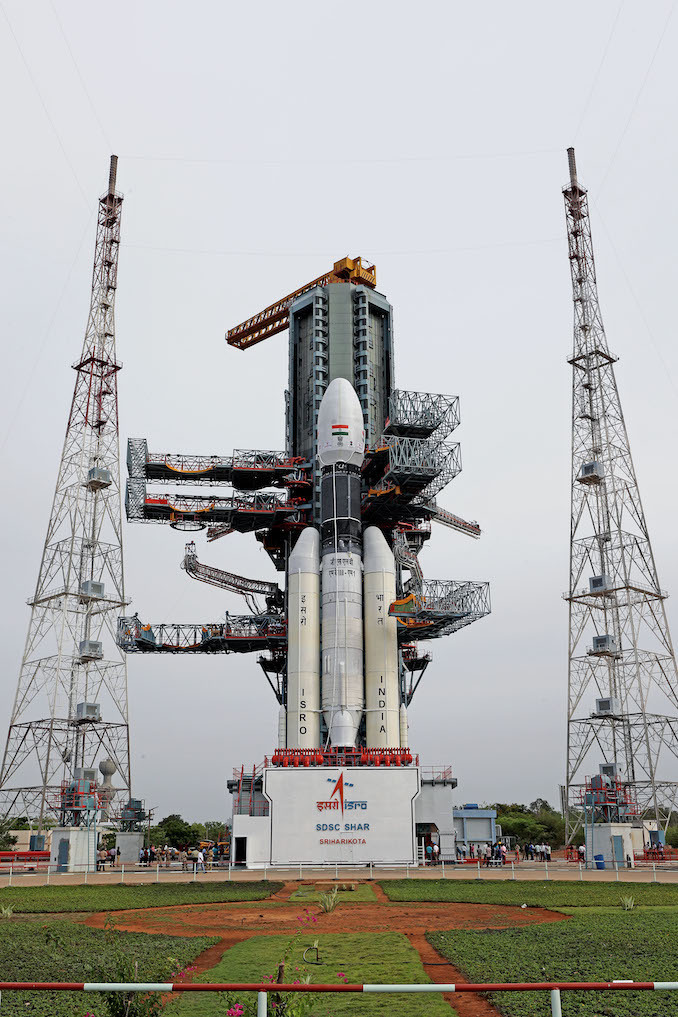
Since the rocket arrived at the launch pad, ISRO’s launch crew at Sriharikota has conducted two launch rehearsals, completed end-to-end checkouts of the rocket, connected pyrotechnics used for in-flight separation events, and accomplished control system checks on the GSLV Mk.3’s first stage.
The launch team also pressurized the rocket’s propellant tanks ini preparation for fueling.
The GSLV Mk.3 rocket will blast off off powered by two 86-foot-long (26.2-meter) S200 solid rocket boosters, generating a combined 2.2 million pounds of thrust. A core stage driven by two hydrazine-fueled Vikas engines will ignite at T+plus 1 minute, 50 seconds, followed by burnout and separation of the strap-on boosters around 30 seconds later.
Each of the S200 solid-fueled boosters will burn through their supply of more than 225 tons (205 metric tons) of pre-packed solid propellants.
The twin Vikas engines fired until around T+plus 5 minutes, 15 seconds, then give way to a cryogenic upper stage powered by liquid hydrogen and liquid oxygen to place the Chandrayaan 2 spacecraft in an elliptical transfer orbit stretching to a maximum altitude of more than 23,000 miles (38,000 kilometers) above Earth.
Chandrayaan 2’s on-board engines will push the spacecraft into higher orbits before breaking free of Earth’s gravitational grasp and heading for the moon, where it will enter orbit in early August.
The orbiter will steer the solar-powered spacecraft into a circular 62-mile-high (100-kilometer) orbit around the moon during a series of maneuvers in August, setting the stage for landing separation and final descent in early September.
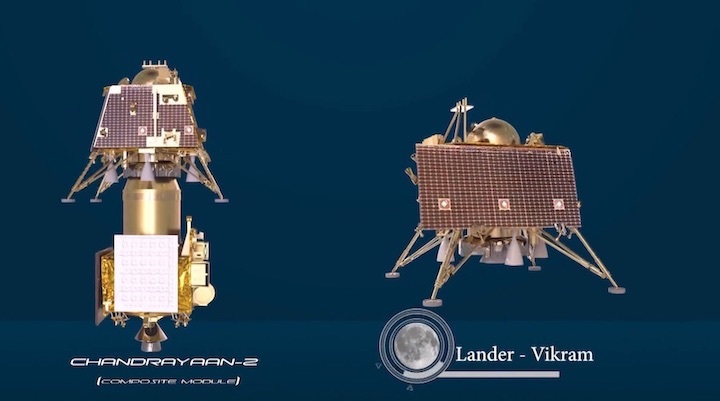
The Chandrayaan 2 spacecraft’s three components each carry a suite of scientific instruments:
- Orbiter
- Mass: 5,244 pounds (2,379 kilograms)
- Power: 1,000 watts
- Description: The Chandrayaan 2 orbiter — designed for a one-year mission — carries eight scientific instruments, including a high-resolution stereo imaging camera, a dual-frequency synthetic aperture radar look for evidence of water ice at the lunar poles, an imaging infrared spectrometer to aid in the search for water, and sensors to study the moon’s tenuous atmosphere. The orbiter will also provide data relay services the Vikram lander.
- Vikram Lander
- Mass: 3,243 pounds (1,471 kilograms)
- Power: 650 watts
- Description: The Vikram lander’s targeted touchdown zone is located in a highland region on the the near side of the moon at approximately 70.9 degrees south latitude, closer to the moon’s south pole than any previous lunar landing mission. Vikram will use five throttleable liquid-fueled engines to slow down for landing. The stationary landing craft carries a suite of multiple cameras and three science instruments, including a seismometer, a thermal probe to reach a depth of up to 33 feet (10 meters) to measure the vertical temperature gradient in the lunar crust, sensors to investigate plasma near the moon’s surface, and a NASA-provided laser retroreflector array to help scientists locate the lander’s exact position on the moon. The Vikram lander is designed to last 14 days on the moon, equivalent to one lunar day.
- Pragyan Rover
- Mass: 59 pounds (27 kilograms)
- Power: 50 watts
- Description: The solar-powered Pragyan rover has a range of up to 500 meters, or 1,640 feet, during its 14-day mission on the moon. The AI-enabled rover has six wheels and will relay science data and images through a radio link with the Vikram lander. Indian scientists installed an alpha particle X-ray spectrometer to measure the elemental composition of the rocks at the Chandrayaan 2 landing site, along with a laser-induced breakdown spectroscope. The Pragyan rover is named for the Sanskrit word for “wisdom.”
The launch of Chandrayaan 2 will mark the first operational flight of India’s GSLV Mk.3 rocket, following a suborbital test flight in 2014 and two successful orbital demonstration missions in 2017 and 2018.
Indian officials have selected the GSLV Mk.3 for the country’s human spaceflight program, which aims to send two or three astronauts into orbit on an Indian-built spacecraft by the end of 2021.
The photos below show the GSLV Mk.3’s rollout Sunday from the assembly building at Sriharikota.
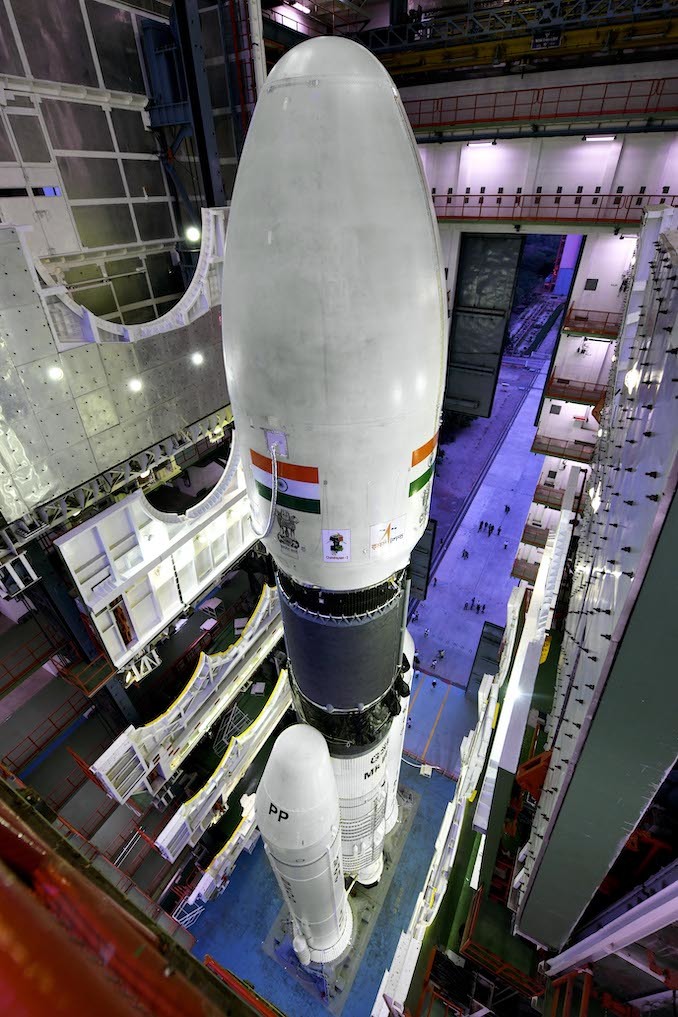
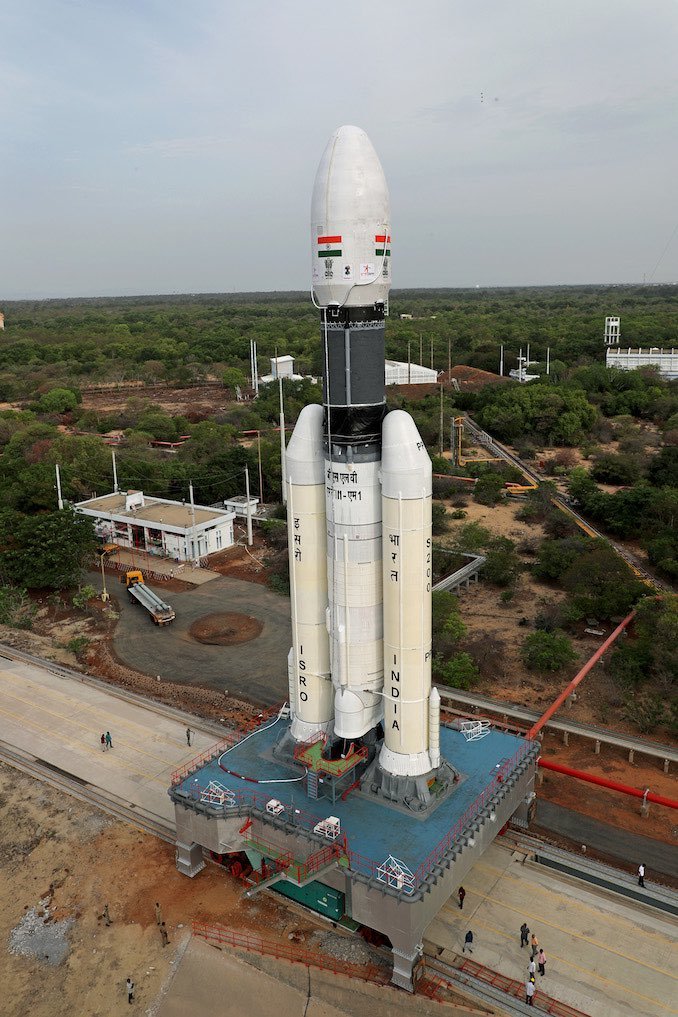
Quelle: SN
----
Update: 15.07.2019 / 7.30 MESZ
.
GSLV MkIII-M1/Chandrayaan 2: Filling of liquid oxygen in Cryogenic stage of GSLV MkIII-M1 completed
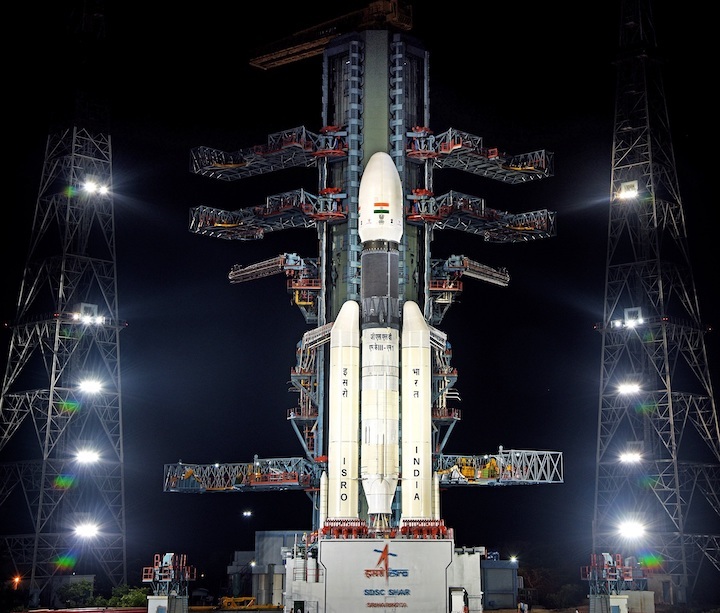
Chandrayaan-2 will be launched from Satish Dhawan Space Center at Sriharikota on-board GSLV Mk-III on 15th July 2019. It will be injected into an earth parking 170 x40400 km orbit. A series of maneuvers will be carried out to raise its orbit and put Chandrayaan-2 on Lunar Transfer Trajectory. On entering Moon's sphere of influence, on-board thrusters will slow down the spacecraft for Lunar Capture. The Orbit of Chandrayaan-2 around the moon will be circularized to 100x100 km orbit through a series of orbital maneuvers. On the day of landing, the lander will separate from the Orbiter and then perform a series of complex maneuvers comprising of rough braking and fine braking. Imaging of the landing site region prior to landing will be done for finding safe and hazard-free zones. The lander-Vikram will finally land near South Pole of the moon on 6th September 2019. Subsequently, Rover will roll out and carry out experiments on Lunar surface for a period of 1 Lunar day which is equal to 14 Earth days. Orbiter will continue its mission for a duration of one year.
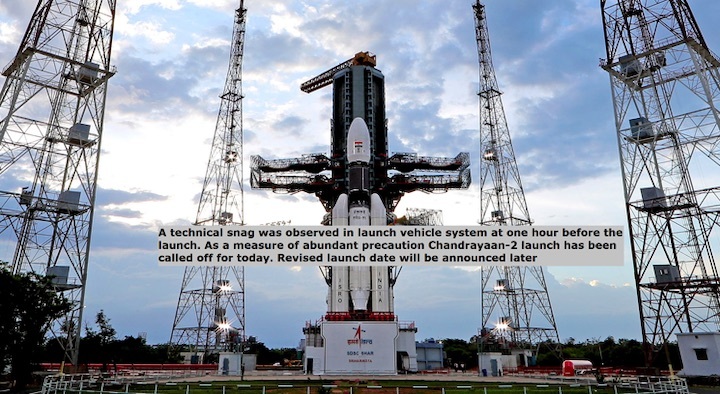
A technical snag was observed in launch vehicle system at one hour before the launch. as a measure of aboundant precaution Chandrayaan-2 launch has been called off for today. Revised launch data will be announced later.
Quelle: ISRO
+++
Update: 18.00 MESZ
.
‘Problem in Chandrayaan-2 rocket, lucky to detect’, say ISRO sources
Chandrayaan 2 Launch Mission: A committee of experts will now examine what went wrong and suggest ways to remove the glitches, it will take about a week to determine what exactly went wrong, the source added.
The launch of Chandrayaan 2 was called off as rocket was not functioning according to laid down parameters, sources at Indian Space Research Organisation (ISRO) told HT, adding that the strategy was to launch the mission as quickly as possible.
“The rocket functioning was not according to laid down parameters... we are extremely lucky to detect the anomaly just before the launch, we are in control, the rocket and satellite are safe,” the source added, hours after the moon mission was called off.
The GSLV Mark III carrying the orbiter, lander, and rover was to take off at 02:51 am Monday morning from Sriharikota, Andhra Pradesh, the country’s only launch site, but the countdown clock was stopped 56 minutes before the scheduled time.
A committee of experts will now examine what went wrong and suggest ways to remove the glitches, it will take about a week to determine what exactly went wrong, the source added.
“We will have to dismantle the rocket to get to the root of the problem… we have window till month end to launch the mission,” the source added.
There were four suitable window periods for the launch in the month of July – July 15 and 16 and then again during new moon on July 29 and 30.
Quelle: hindustantimes
----
Update: 17.07.2019
.
Fans sad at Chandrayaan delay
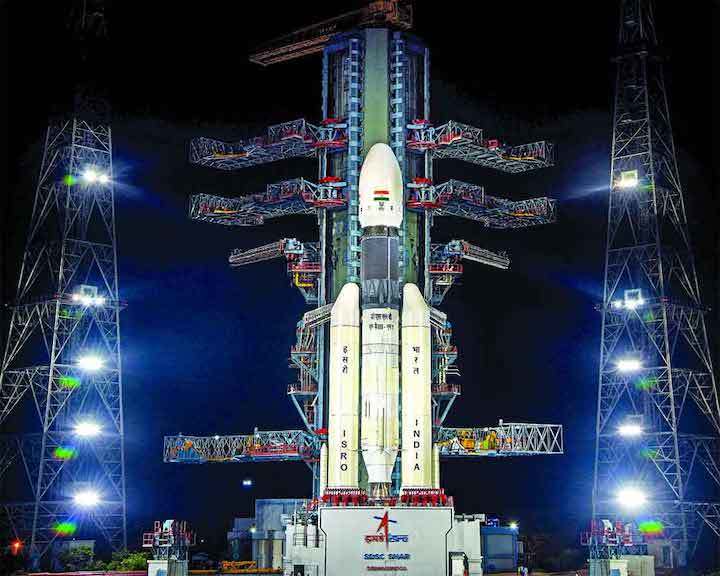
Moon mission put off 1 hour before launch due to snag, experts hail ISRO’s timely decision
India’s second mission to the Moon — Chandrayaan-2 — was called off due to a “technical snag” in its most powerful rocket a little less than an hour before launch from a spaceport here in the early hours of Monday. Scientists of the Indian Space Research Organisation (ISRO) were assessing the seriousness of the problem with the heavylift rocket GSLV Mk-III rocket carrying the satellite that put a halt to the ambitious Rs 976 crore lunar mission amid uncertainty over a future launch date.
The ISRO was tightlipped as to what may have caused the glitch that occurred when liquid propellant was being loaded into the rocket’s indigenous cryogenic upper stage engine. But several space scientists said the space agency must be appreciated for calling off the launch of rather than hurrying into a major disaster.
Despite the odd hour, enthusiasts of all ages reached the island, some of them travelling long distances on two wheelers, to witness the proud moment. The men, women and children waiting at a special gallery, set up recently by ISRO, left the venue disappointed as the mission did not go as expected. ISRO had set up the gallery — inaugurated by Chairman K Sivan a few months ago — on the sprawling Sriharikota premises as the number of spectators turning up to witness launches has been increasing over time. “We do not know what happened but we are disappointed. I hope they rectify whatever the issue is. We will come back again to witness the launch,” said a young boy, holding aloft the tricolour, who had come with his family.
A man standing nearby said it was good scientists had called off the launch when the rocket was still on the ground. “If it had gone into space and something had happened there, the huge amount of money spent on the mission would have gone to waste,” he said.
Watched by President Ram Nath Kovind, the countdown to the launch of Chandrayaan-2 on board Geosynchronous Launch Vehicle GSLV-Mk-III, dubbed as “Baahubali”, was scheduled for 2.51 am on Monday. The mission was stopped 56 minutes and 24 seconds before lift-off at 1.55 am following an announcement from the Mission Control Centre. Confusion prevailed for several minutes before the ISRO came out with an official confirmation about the launch being cancelled.
“A technical snag was observed in the launch vehicle system at t-minus 56 minutes. As a measure of abundant precaution Chandrayaan 2 launch has been called off for today,” ISRO Associate Director (Public Relations) BR Guruprasad said. He did not specify the nature of the snag. A revised launch date will be announced later, he added.
“Launch is called off due to technical snag. It is not possible to make the launch within the (launch) window. (A new) launch schedule will be announced later,” another ISRO official said,
India’s space agency had earlier scheduled the launch in the first week of January but shifted it to July 15. The lift-off of the three-component spacecraft weighing 3,850 kg and comprising an orbiter, the lander and the rover was scheduled from the Satish Dhawan Space Centre (SDSC) in Sriharikota, off the coast of Andhra Pradesh.
The satellite was supposed to explore the uncharted lunar south pole, 11 years after ISRO’s successful first lunar mission — Chandrayaan-1, which made more than 3,400 orbits around the moon and was operational for 312 days till August 29, 2009. It would have taken 54 days to accomplish the task of landing on the Moon through meticulously planned orbital phases.
After a full dress rehearsal last week, the countdown for the mission commenced at 6.51 am on Sunday and scientists had undertaken various stages of propellant filling to power the rocket ahead of the launch. Billed as the most complex and prestigious mission ever undertaken by the ISRO since its inception, Chandrayaan-2 would have made India the fourth country to soft land a rover on the lunar surface after Russia, the United States and China.
“ISRO has an exceptional success rate when it comes to launching systems. Checking and diagnosing complex systems in a rocket till the last minute is an art by itself, which they seem to have mastered,” said Rajesh Kumble Nayak, head of the Centre for Excellence in Space Sciences India in Kolkata’s Indian Institute of Science Education and Research (IISER).
“I am glad that people at ISRO decided to hold back rather than hurrying into a major disaster. I guess the mission will be held back for a few weeks, which is much better than a failure,” Nayak told PTI.
Quelle: The Pioneer
----
Update: 20.07.2019
,
Chandrayaan 2 is ready to take a billion dreams to the Moon — now stronger than ever before! Join us for the launch on Monday — 22 July, 2019 — at 2:43 PM IST.
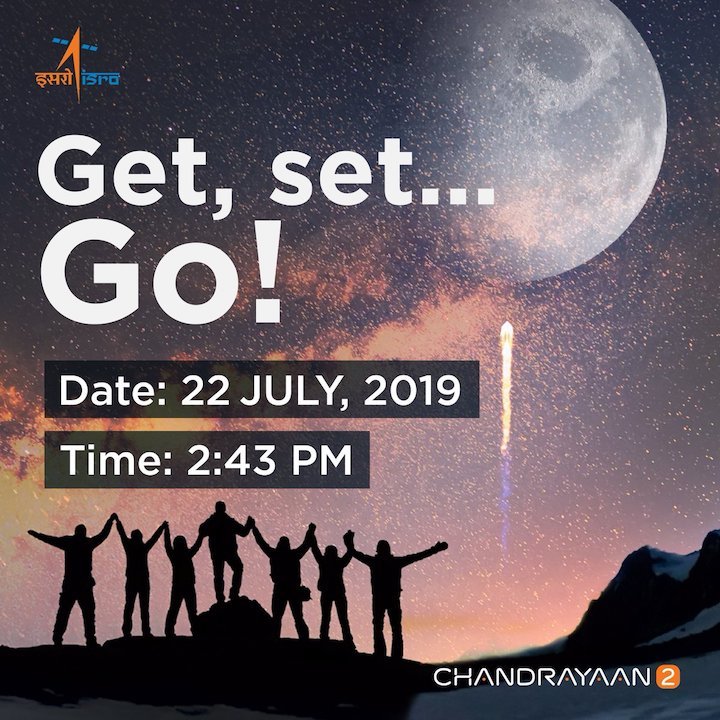
Quelle: ISRO
----
Update: 21.07.2019
.
Countdown for Chandrayaan-2 mission begins at Sriharikota space centre
The twenty-hour countdown for India’s second lunar mission Chandrayaan-2 began this evening at the national spaceport at Sriharikota. The Indian Space Research Organization ISRO said, the countdown started at 6.43 pm and is progressing smoothly. The country’s most powerful booster, GSLV-Mark-Three, will take off at 2.43 hrs in the afternoon tomorrow, carrying the high-stake Chandrayaan-2 probe from the second launch pad of the space station. The launch rehearsal made by the ISRO today has found that all mission parameters are normal.
ISRO Chairman Dr K Sivan told reporters at Chennai Airport this morning that the technical snag that occurred in the rocket GSLV-Mark-Three on July 15 has been fully rectified. He said all preparations have been made for the launch tomorrow. He informed that fifteen crucial manoeuvres would be made after the launch for navigating Chandrayaan-2 to reach the moon.
The 43.43 meters long, 640-ton rocket GSLV-Mark-Three will take Chandrayaan-2 to a highly elliptical orbit around the earth. From there, it will be taken to the South Pole of the moon by 7th September, by carrying out multiple firing of the engine onboard Chandrayaan-2, as said by ISRO.
The 978 crore rupees worth mission would propel India as the fourth country ever in the elite club of nations having their own probes soft landing on the moon.
Chandrayaan-2 weighing 3.85 ton consisting of the orbiter, the lander and the rover have a total of 13 payloads to study the moon and a facility for passive experiment. The orbiter and the lander are capable of sending data to the ISRO’s Deep Space Network at Byalalu near Bengaluru. The lander is to descend on a high plain between two craters in the moon’s South Pole. Space scientists view the moon as a test-bed for deep space ventures. The present moon expedition is one of the most complex space missions ever made by the nation. The snags found in the cryogenic upper stage of the rocket just before an hour of the previously scheduled launch on the 15th of this month have been plugged, boosting the confidence of the scientists to have the mission during the prevailing launch window itself. Apart from the potential to unveil the secrets of the moon, the mission is all set to rekindle scientific temper among the youth of the nation.
Quelle: ALL INDIA RADIO

